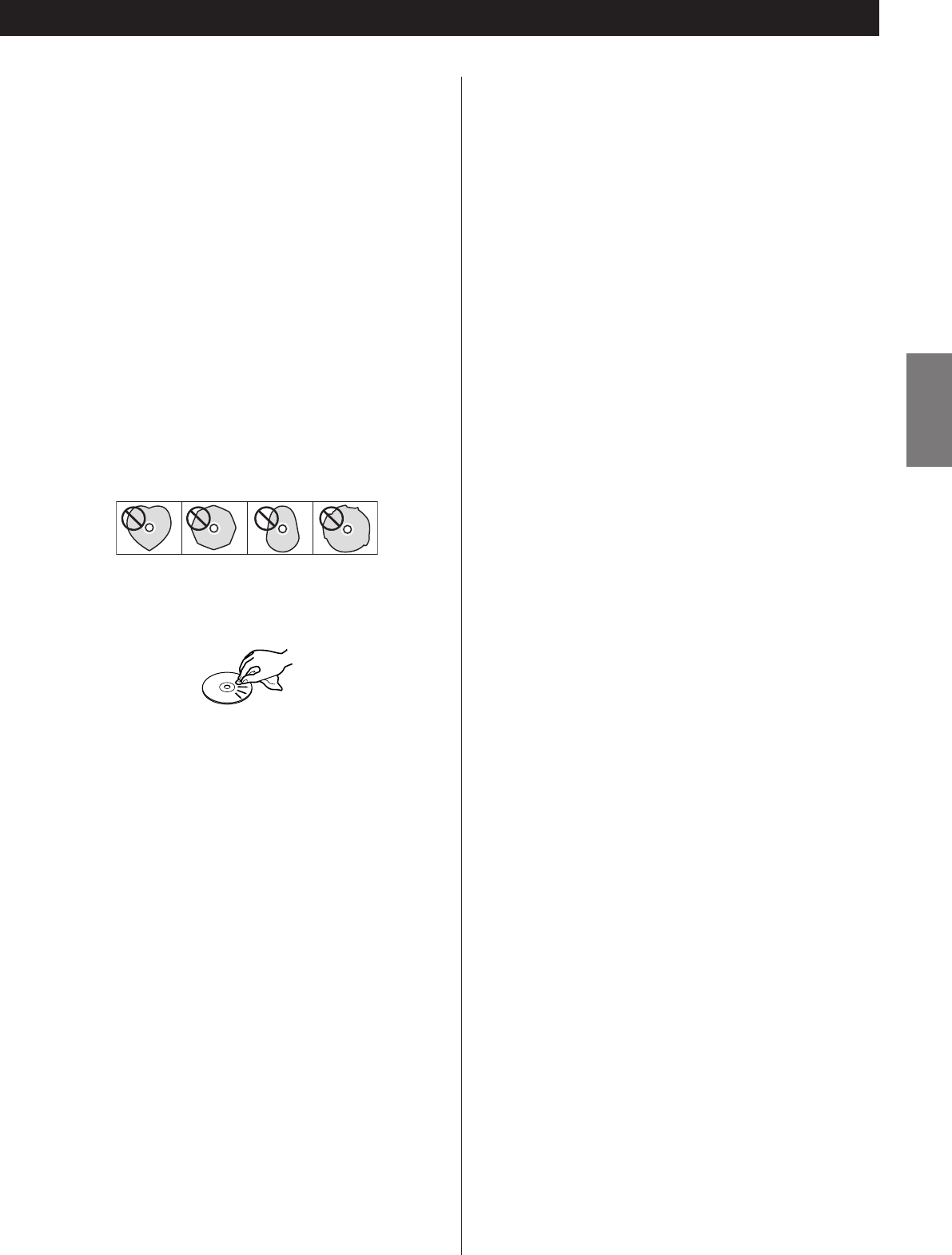
7
ENGLISH
CAUTION:
< Do not play any disc that is warped, deformed or damaged.
Playing such discs may cause irreparable harm to the playing
mechanisms.
< Printable CD-R and CD-RW discs are not recommended, as the
label side might be sticky and damage the unit.
< Do not stick papers or protective sheets on the discs and do not
use any protective coating spray.
< Use a soft oil-based felt-tipped pen to write the information on
the label side. Never use a ball-point or hard-tipped pen, as this
may cause damage to the recorded side.
< Never use a stabilizer. Using commercially available CD stabilizers
with this unit will damage the mechanisms and cause them to
malfunction.
< Do not use irregularly shaped discs (octagonal, heart shaped,
business card size, etc.). CDs of this sort can damage the unit.
Maintenance
< If the disc becomes dirty, wipe the surface radially from the center
hole outward towards the outer edge with a soft and dry cloth.
< Never use such chemicals as record sprays, antistatic sprays
or fluid or thinner to clean the discs. Such chemicals will do
irreparable damage to the disc’s plastic surface.
Storage precautions
< Discs should be returned to their cases after use to avoid dust
and scratches that could cause the laser pickup to “skip.”
< Do not expose discs to direct sunlight or high-temperature
and humidity for extended periods. Long exposure to high
temperatures will warp the disc.
< CD-R and CD-RW discs are more sensitive to the effects of heat
and ultraviolet rays than ordinary CDs. It is important that they
are not stored in a location where direct sunlight will fall on
them, and away from sources of heat such as radiators or heat-
generating electrical devices.
If you are in any doubt as to the care and handling of a CD-R or
CD-RW disc, read the precautions supplied with the disc, or contact
the disc manufacturer.
About CD-R and CD-RW discs
CD-R discs can be recorded once only. Once they have been used
for recording, they cannot be erased or re-recorded.
However, if space is available on the disc (and the disc has not
been finalized), additional material can be recorded.
By contrast, a CD-RW disc can be used in much the same way as a
CD-R disc, but the last track or tracks recorded can be erased, and
the space on the disc can be re-used for other recordings.
However, you should note that an audio CD created using a
CD-RW disc may not play back satisfactorily on every audio CD
player.
CD-R, by contrast, may be played satisfactorily on the majority of
audio CD players.
Finalizing
Although audio data may be written on a CD-R or CD-RW disc, a
standard CD player will not be able to play back the audio until a
final table of contents (TOC) has been written at the start of the
disc.
The process of writing this table of contents is known as
“finalizing”. Once this has been done, no further data can be
written to the disc.
Note that a CD-RW disc that has been finalized can be
“unfinalized”. This allows further tracks to be recorded to the disc,
provided that there is space on the disc.
< Repeat, shuffle and programmed playback do not work with
unfinalized (NO TOC) discs.
Recordable discs
In this manual, we use the term “recordable” disc to describe a
CD-R or CD-RW disc that has not been finalized, and has enough
space to record.
If a high-speed CD-RW disc (4X or more) is finalized using this
unit, the disc may not be able to play on some other CD player.


















